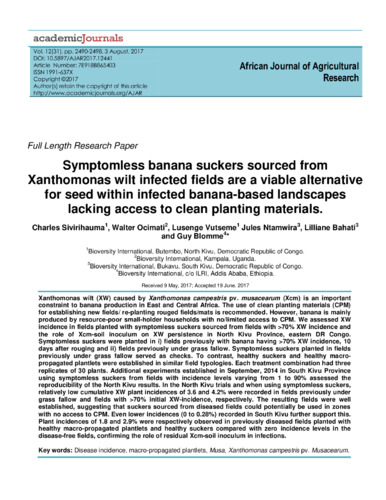Symptomless banana suckers sourced from Xanthomonas wilt infected fields are a viable alternative for seed within infected banana-based landscapes lacking access to clean planting materials
Xanthomonas wilt (XW) caused by Xanthomonas campestris pv. musacearum (Xcm) is an important constraint to banana production in East and Central Africa. The use of clean planting materials (CPM) for establishing new fields/ re-planting rouged fields/mats is recommended. However, banana is mainly produced by resource-poor small-holder households with no/limited access to CPM. We assessed XW incidence in fields planted with symptomless suckers sourced from fields with >70% XW incidence and the role of Xcm-soil inoculum on XW persistence in North Kivu Province, eastern DR Congo. Symptomless suckers were planted in i) fields previously with banana having >70% XW incidence, 10 days after rouging and ii) fields previously under grass fallow. Symptomless suckers planted in fields previously under grass fallow served as checks. To contrast, healthy suckers and healthy macro-propagated plantlets were established in similar field typologies. Each treatment combination had three replicates of 30 plants. Additional experiments established in September, 2014 in South Kivu Province using symptomless suckers from fields with incidence levels varying from 1 to 90% assessed the reproducibility of the North Kivu results. In the North Kivu trials and when using symptomless suckers, relatively low cumulative XW plant incidences of 3.6 and 4.2% were recorded in fields previously under grass fallow and fields with >70% initial XW-incidence, respectively. The resulting fields were well established, suggesting that suckers sourced from diseased fields could potentially be used in zones with no access to CPM. Even lower incidences (0 to 0.28%) recorded in South Kivu further support this. Plant incidences of 1.8 and 2.9% were respectively observed in previously diseased fields planted with healthy macro-propagated plantlets and healthy suckers compared with zero incidence levels in the disease-free fields, confirming the role of residual Xcm-soil inoculum in infections.

